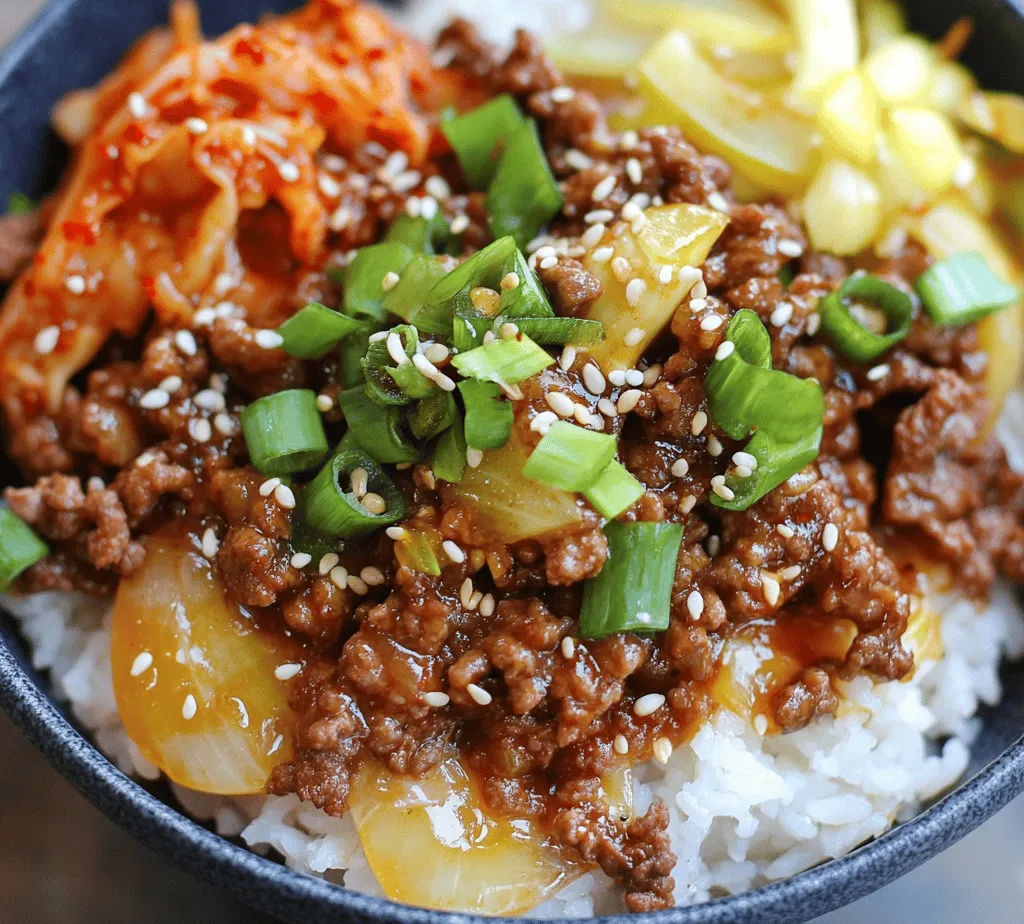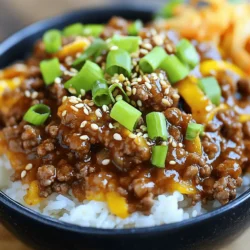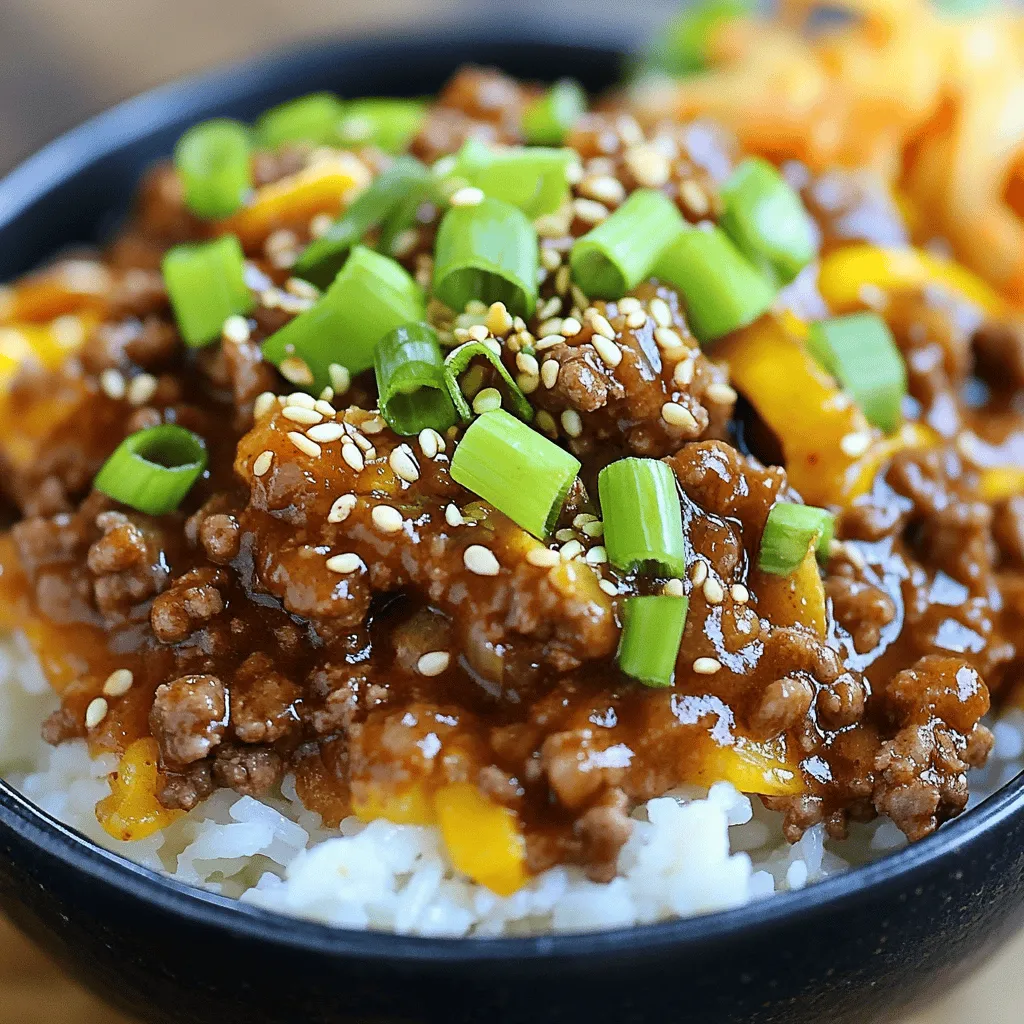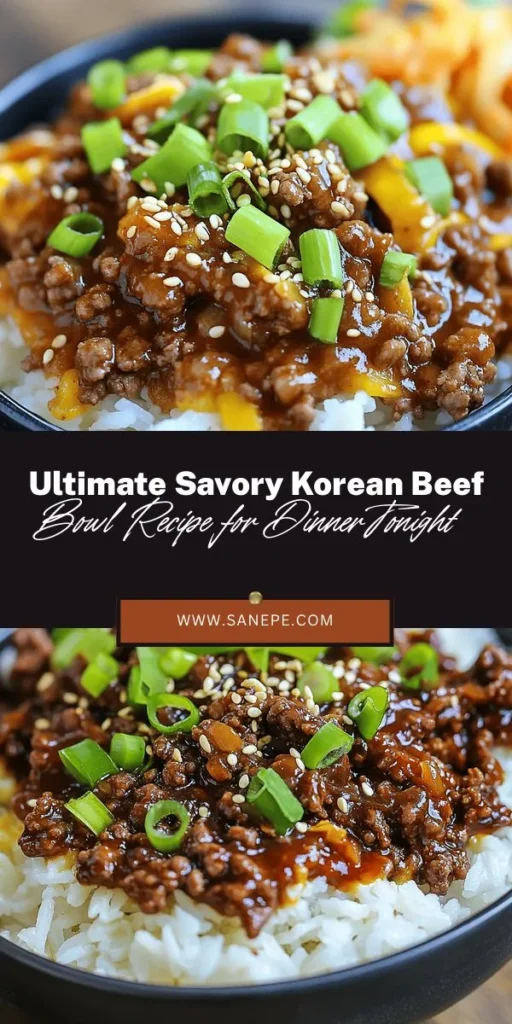Korean cuisine has taken the culinary world by storm, capturing the hearts (and stomachs) of food lovers everywhere. With its bold flavors, vibrant colors, and diverse ingredients, it’s no wonder that dishes like kimchi, bibimbap, and bulgogi have become staples in kitchens far and wide. One dish that perfectly encapsulates the essence of Korean cooking is the Savory Korean Beef Bowl. This easy-to-make recipe not only brings the taste of Korea to your home but also offers a delightful balance of flavors that make it ideal for weeknight dinners or meal prep.
The Savory Korean Beef Bowl is a harmonious blend of seasoned ground beef, fresh vegetables, and aromatic spices. It’s a dish that showcases the core of Korean cuisine—sweet, savory, and spicy—all in one bowl. Whether you are a seasoned cook or a beginner in the kitchen, this recipe promises to be a hit with family and friends. It’s quick to prepare, making it a perfect choice for busy evenings when you crave something delicious without spending hours cooking.
Understanding the Key Ingredients
To create an unforgettable Savory Korean Beef Bowl, it’s essential to understand the key ingredients that contribute to its unique flavor profile. Each element plays a crucial role in delivering the authentic taste of Korea right to your dining table.
Ground Beef
The star of the dish is undoubtedly the ground beef. For optimal flavor and texture, a beef blend with an 80/20 ratio of meat to fat is recommended. This combination ensures that the beef remains juicy and flavorful while cooking. Ground beef is not just a delicious choice; it also offers several nutritional benefits. It is a great source of protein, iron, and essential B vitamins, which are pivotal for energy production and overall health.
In Korean cooking, beef is often marinated and cooked quickly to preserve its tenderness. The ground form makes it easy to absorb flavors from the sauces and spices, resulting in a rich and satisfying dish.
Aromatics: Garlic and Ginger
No Korean dish is complete without the aromatic duo of garlic and ginger. These ingredients are vital in enhancing the overall flavor profile of the Savory Korean Beef Bowl. Garlic adds a pungent, savory note, while ginger brings a warm, slightly sweet flavor that complements the beef perfectly.
Beyond their flavor contributions, garlic and ginger are also known for their numerous health benefits. Garlic is praised for its potential to boost the immune system, lower blood pressure, and improve cholesterol levels. On the other hand, ginger is renowned for its anti-inflammatory properties and digestive benefits. Together, they create a fragrant base that elevates the dish to another level.
Savory and Sweet: Soy Sauce and Brown Sugar
The balance of savory and sweet flavors is a hallmark of Korean cuisine, and this recipe achieves that balance through the use of low sodium soy sauce and brown sugar. Low sodium soy sauce is essential for seasoning the beef without overwhelming it with saltiness. It contributes an umami flavor that is fundamental in Korean dishes.
Brown sugar plays a dual role in this recipe. Not only does it add sweetness to the beef, but it also caramelizes during cooking, creating a beautiful glaze that enhances the savory notes. This combination of soy sauce and brown sugar creates a sticky, flavorful coating on the beef that is utterly irresistible.
The Unique Touch of Korean Ingredients
Sesame Oil and Rice Vinegar
To round out the flavor profile of the Savory Korean Beef Bowl, sesame oil and rice vinegar are added. Sesame oil is a staple in Korean cooking; its rich, nutty flavor adds depth to the dish. A drizzle of sesame oil at the end of cooking can transform a simple meal into an extraordinary culinary experience.
Rice vinegar, on the other hand, provides a subtle acidity that helps to balance the sweetness of the brown sugar. It cuts through the richness of the beef, making every bite refreshing and satisfying.
Gochujang: The Soul of Korean Spice
Perhaps the most iconic ingredient in Korean cuisine is gochujang, a fermented chili paste that adds a distinctive heat and depth of flavor to the dish. Gochujang is made from red chili powder, glutinous rice, fermented soybeans, and salt, creating a complex flavor profile that is both spicy and slightly sweet. It’s the soul of Korean spice and is essential in achieving the authentic taste of the Savory Korean Beef Bowl.
In addition to its incredible flavor, gochujang is packed with health benefits. It contains capsaicin, which is known for its metabolism-boosting properties, and is rich in antioxidants, making it a flavorful yet nutritious addition to your meal.
Garnishes that Elevate the Dish
No dish is complete without a few garnishes to add color, texture, and flavor. In this Savory Korean Beef Bowl, sliced green onions and sesame seeds play an integral role. Green onions not only add a pop of color but also provide a fresh crunch that contrasts beautifully with the tender beef.
Sesame seeds, whether toasted or raw, bring a delightful nuttiness and a bit of texture to the dish. For those looking to elevate their bowl even further, consider adding a side of kimchi. This fermented vegetable dish is a staple in Korean cuisine and adds a tangy, spicy kick that complements the savory beef perfectly.
Step-by-Step Guide to Making Savory Korean Beef Bowl
Preparation: Getting Started
Before diving into the cooking process, it’s important to prepare all your ingredients. Having everything prepped and ready to go will ensure a smooth cooking experience. Start by gathering all the ingredients: ground beef, garlic, ginger, soy sauce, brown sugar, sesame oil, rice vinegar, gochujang, green onions, and sesame seeds.
Chop the garlic and ginger finely to maximize their flavor release during cooking. Slice the green onions, separating the white parts from the green, as they will be used at different stages of the cooking process. This preparation will not only save time but also enhance the overall cooking experience, allowing you to enjoy the process as much as the end result.
Now that you are well-versed in the key ingredients and their roles in the dish, you are ready to embark on your flavorful journey to Korea with this Savory Korean Beef Bowl recipe. Let’s get started with the cooking process, where all these wonderful flavors will come together to create a satisfying and delicious meal.

Suggestions for How to Prepare Rice Ahead of Time
A well-prepared rice base is crucial for a delicious Korean Beef Bowl. Preparing rice ahead of time not only saves you valuable cooking time but also allows the flavors of your dish to meld beautifully. Here are a few methods to ensure you have perfectly cooked rice ready for your savory beef:
1. Cook and Store: You can cook your rice a day in advance. Simply follow your preferred method—whether that’s stovetop, rice cooker, or Instant Pot. Once done, cool the rice, transfer it to an airtight container, and refrigerate. When you’re ready to serve, reheat in a microwave or on the stovetop with a splash of water to restore moisture.
2. Freezing Cooked Rice: Another great option is to freeze your cooked rice. Allow the rice to cool completely, then portion it into freezer-safe bags. When you need it, simply thaw in the fridge overnight or microwave it directly from the freezer, adding a little water to keep it fluffy.
3. Rice Cooking Tips: If you’re starting from scratch, consider using jasmine or short-grain rice for a stickier texture that pairs well with the beef. Remember to rinse the rice before cooking to remove excess starch, which helps prevent it from becoming gummy.
Cooking the Beef
Cooking ground beef to perfection is key in creating a delicious Korean Beef Bowl that is juicy and full of flavor. Here’s how to do it right:
1. Selecting the Right Beef: Choose high-quality ground beef, ideally with a fat content between 80/20 and 85/15. This balance provides enough fat for flavor without becoming overly greasy.
2. Heat Your Pan: Start with a large, non-stick skillet or wok over medium-high heat. Allow it to get hot before adding the beef; this helps achieve a nice browning.
3. Browning the Beef:
– Add the ground beef to the hot pan in a single layer and let it sear without stirring for about 2-3 minutes. This allows it to develop a rich, caramelized flavor.
– Use a spatula to break it apart and continue cooking. Stir occasionally until the beef is browned and cooked through, which should take about 5-7 minutes in total.
4. Managing Grease: As the beef cooks, you may notice excess grease. To manage this, you can use a spoon to skim off the excess fat or drain some of it off. Just leave enough to add flavor to the dish.
Infusing Flavor with Aromatics
Aromatics are the backbone of flavor in your Korean Beef Bowl. Garlic and ginger add depth, but timing is crucial to avoid burning them:
1. Sautéing Garlic and Ginger:
– Once the beef is cooked, push it to one side of the pan and add a drizzle of oil to the empty space.
– Add minced garlic (2-3 cloves) and grated ginger (about 1 tablespoon) to the pan. Sauté for about 30 seconds, stirring constantly to prevent burning. You want them to become fragrant but not browned.
2. Timing for Flavor Infusion: Timing is essential when adding aromatics. By sautéing them just before combining with the beef and sauce, you ensure they infuse their flavors into the dish without losing their freshness.
Creating the Perfect Sauce
The sauce is what brings all the elements of the Korean Beef Bowl together. Here’s how to make a well-balanced, flavorful sauce:
1. Ingredients for the Sauce:
– In a bowl, whisk together soy sauce (1/4 cup), brown sugar (2 tablespoons), sesame oil (1 tablespoon), rice vinegar (1 tablespoon), and cornstarch (1 tablespoon). The cornstarch not only helps thicken the sauce but also gives it a glossy finish.
2. Whisking for Even Consistency: Ensure you whisk the sauce thoroughly until the cornstarch is fully dissolved. This will prevent any lumps in your sauce when it’s added to the beef.
3. Understanding Cornstarch: Cornstarch acts as a thickening agent, creating a luscious consistency that clings to the beef and rice. When heated, it gelatinizes, ensuring your sauce has the right texture.
Combining Ingredients and Simmering
Now that you have your beef, aromatics, and sauce ready, it’s time to combine everything for maximum flavor absorption:
1. Mixing the Beef and Sauce: Pour the prepared sauce over the browned beef and aromatics in the skillet. Stir well to combine, ensuring all the beef is coated with the sauce.
2. Simmering for Flavor: Allow the mixture to simmer on medium heat for about 2-3 minutes. This will help the sauce thicken and the flavors to meld together beautifully. Keep an eye on the thickness; if it’s too thin, continue cooking until it reaches your desired consistency.
3. Adjusting Sauce Thickness: If the sauce becomes too thick, add a splash of water or beef broth to loosen it. Conversely, if it’s too thin, let it simmer a bit longer to evaporate excess liquid.
Serving Suggestions
Plating your Korean Beef Bowl beautifully enhances the dining experience. Here are some best practices and ideas for variations:
1. Plating the Dish: Start with a generous scoop of rice at the bottom of the bowl. Top with a portion of the sautéed beef and sauce. Garnish with sliced green onions, sesame seeds, and maybe a sprinkle of kimchi for an added punch.
2. Variations: Feel free to customize your beef bowl. Add sautéed vegetables such as bell peppers, broccoli, or carrots for extra nutrients and color. You could also switch the ground beef for ground turkey or chicken for a lighter option.
3. Pairing with Sides: Korean Beef Bowls pair wonderfully with a side of pickled vegetables, steamed broccoli, or a refreshing cucumber salad. For a complete meal, serve with a small bowl of miso soup or a light salad.
Nutritional Information
Understanding the nutritional content of your dish can help you make informed choices. Here’s a breakdown per serving of your Korean Beef Bowl:
– Calories: Approximately 450-500 calories
– Protein: Around 30-35 grams
– Carbohydrates: About 45-50 grams
– Fat: 20-25 grams
– Fiber: 2-3 grams
Dietary Modifications: If you’re looking for lower-carb options, consider substituting rice with cauliflower rice or zucchini noodles. For gluten-free versions, use tamari instead of soy sauce.
Cultural Context of Korean Beef Bowls
Korean Beef Bowls, or “Bibimbap,” embody the essence of Korean cuisine, emphasizing balanced flavors and textures. Beef is often a central ingredient due to its rich taste, and the versatility of the dish allows it to be adapted to various preferences.
1. Significance in Korean Cuisine: Beef bowls represent not just a meal but a cultural experience, often served during family gatherings and celebrations. The harmony of flavors and colors reflects the Korean philosophy of balance in food.
2. Comparison with Other Dishes: Unlike other Korean dishes such as bulgogi, which features marinated beef, the Korean Beef Bowl emphasizes the natural flavors of the beef, enhanced by the sauce and aromatics. Each dish shares a common foundation of kimchi and rice but diverges in preparation and taste.
Conclusion
The Savory Korean Beef Bowl is more than just a quick meal; it’s a delightful journey into the heart of Korean cooking. The combination of perfectly cooked beef, fragrant aromatics, and a rich sauce served over warm rice creates a satisfying dish that’s both comforting and flavorful.
We encourage you to explore more Korean recipes, as each dish tells a story and connects you to a rich cultural heritage. Embrace the joy of cooking at home, and enjoy the delicious flavors that come from authentic recipes. Whether you’re cooking for yourself or sharing with family and friends, a well-prepared Korean Beef Bowl is sure to impress and satisfy.


